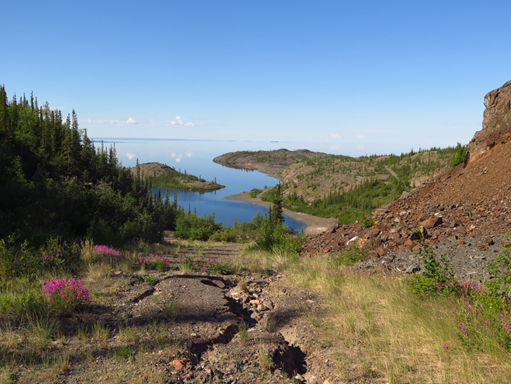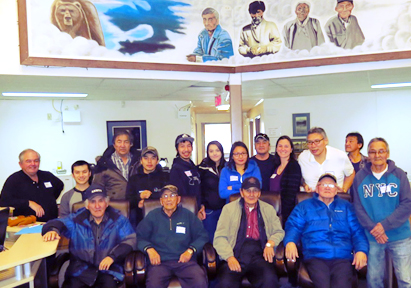Port Radium
Overview

The Port Radium Mine was located on a peninsula along the eastern shore of Great Bear Lake in the Northwest Territories, 440 km north of Yellowknife and 265 km east of Délįnę.
Beginning in 1932, the site was mined for radium used in medical research. From the early 1940s to the 1960s, the site was mined for uranium. It was then mined for silver from the 1960s until 1982. When the silver mine closed, it was decommissioned according to the standards of the time. Tailings were covered, mine openings were blocked, infrastructure was demolished and all valuable equipment was removed.
CIRNAC continues to monitor Port Radium to reduce risks to Canadians and the environment. Since 2000 the site has been further assessed and studied because of concerns raised by the community of Délįnę.
Issues at this site
While CIRNAC has remediated the site, three types of residual risks remain:
- Radiation: Uranium levels are naturally high in the rock throughout the site. As such, the natural rock emits low levels of radiation. The mine tailings also emit low level radiation. These have been capped.
- Elevated levels of metals in soil and surface water: As a result of naturally elevated levels of metals in the rock and more than 40 years of mining, silver, copper and uranium are present in soils and surface water. The levels are similar in mining-impacted areas such as the McDonough Tailings Containment Area, as well as nearby untouched lakes, such as Glacier Lake.
- Hydrocarbon contaminated soils: Leftover hydrocarbon from fuel used in mining is still found in the fine-grained soil in the exposed bedrock at Silver Point. Monitoring has shown that the site does not affect the water in Great Bear Lake.
Engagement approach
- Regular meetings: CIRNAC continues to engage the Délįnę First Nation to inform members about the ongoing monitoring results at the site.
- Port Radium Working Group: The Port Radium Working Group includes elders, youth, and members from Délįnę, as well as the CIRNAC Port Radium Remediation Project team.
What work has been done?
- 2005
- CIRNAC and Délįnę completed studies and recommendations on how to address the site through the the Canada- Délįnę Uranium Table (CDUT).
- 2008
- CIRNAC completed the remediation of the Port Radium site as recommended by the CDUT . In addition to on-site work, activities included a training program, science camps, and sharing and incorporating traditional knowledge. The cleanup of the Glacier Bay exploration site was added to the remediation program because it was so close to the main site.
- 2009-2011
- Ongoing annual monitoring of the Port Radium site confirmed the remediation goals were being met.
- 2012
CIRNAC conducted a state-of-the-environment study to ensure that the project was still meeting its monitoring goals. This included looking at fish and ecosystems (soil, sediment, vegetation) health in the Great Bear Lake area around Port Radium. It also included a site-wide survey to ensure that the radiation covers were working.
The Canadian Nuclear Safety Commission (CNSC) also conducted a site inspection. The inspection confirmed that the remediation methods are working as planned.
- 2013
- Remediation work was completed to meet the final Sahtu Land and Water Board regulatory requirements. The land use permit for the site is now closed but monitoring will continue. CNSC continues to regulate the site.
- 2014
- Monitoring activities included checking for:
- gamma radiation levels
- water quality
- geotechnical visual inspection
- small resident fish species
- benthos: the life forms that live in the water and sediment that fish often eat, such as insect larvae and worms
- sediments
- 2015
-
CIRNAC performed a hydrological assessment of the McDonough tailing containment area. The assessment confirmed that the contaminated water was not at risk of discharging into the surrounding area.
CIRNAC assessed a new dip in the surface cover to stabilize and minimize erosion in the area. The assessment determined that the cover was working as planned. Minor shifts in the landscape of the cover are expected as the rocks under it settle over time.
- 2016
-
A state-of-the-environment study was completed. This study is usually done every five years. CIRNAC completed the study one year ahead of schedule in order to support the renewal of the Waste Nuclear Substance Licence (WNSL) from the CNSC. This licence allows CIRNAC to remain in compliance and continue monitoring the site.
The CNSC also conducted a site inspection in 2016. The inspection confirmed that the remediation methods are working as planned.
What's next?

CIRNAC is partnering with the community to find new ways to work together to monitor the Port Radium site. Together, CIRNAC and the Port Radium Working Group are developing a new long-term monitoring plan for the site. This plan will incorporate traditional knowledge and address the concerns of the community. The working group aims to complete the plan in 2017.